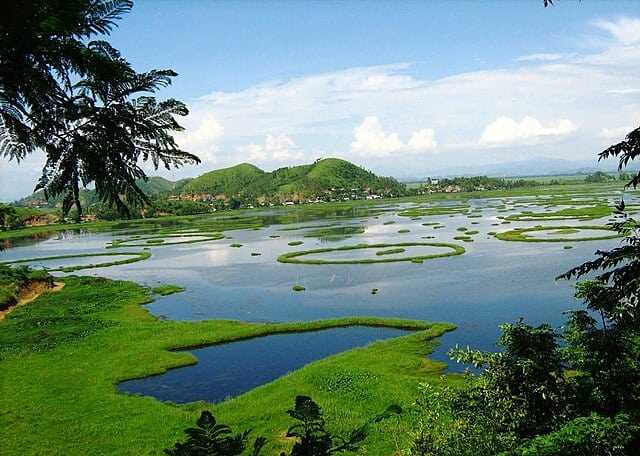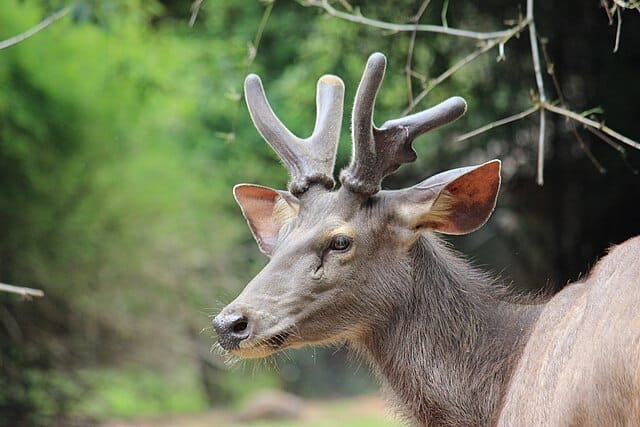Keibul Lamjao National Park in Manipur preserves endangered Sangai deer, floating Phumdis, and centuries-old Meitei cultural heritage.
Keibul Lamjao National Park is no ordinary stretch of wilderness. It holds the remarkable distinction of being the world’s only floating national park, resting atop the shimmering expanse of Loktak Lake, Manipur. This 40-square-kilometre protected area, enriched by the surrounding buffer zones of Loktak Lake and Pumlen Pat, forms the Keibul Lamjao Conservation Area (KLCA)—an ecological and cultural masterpiece unlike any other in India.

What sets this park apart is its unique ecosystem known as the Phumdi, dense floating mats of vegetation, soil, and organic matter that drift over the lake’s surface. These living islands rise and fall with the seasons, offering a buoyant landscape where the rare and elegant Sangai deer, Manipur’s state animal, walks as if in a delicate dance. The habitat is further shaped by a raised strip of land dividing the park into two zones, creating a blend of floating meadows and semi-solid terrain.
Loktak Lake itself, the largest freshwater lake in Northeast India, supports this extraordinary ecosystem. Oval in shape and dotted with hillock islands like Sendra, Thanga, and Ithing, the lake is not only a natural marvel but also a cradle of culture and livelihoods. Divided into northern, central, and southern zones, its varied vegetation, Phumdi thickness, and drainage patterns create diverse habitats. The depth of the lake ranges between half a metre and over four metres, with seasonal blooms of water lilies and lotuses turning its surface into a canvas of colour.
History and Culture of Keibul Lamjao National Park
The park’s most famous resident is the Sangai, also known as the brow-antlered deer (Rucervus eldi eldi). Once thought to be extinct, it was rediscovered in 1953 and has since become the symbol of conservation in Manipur. With its forward-curving antlers and graceful movements across the Phumdi, the Sangai is woven into the very folklore and legends of the land.
Stories abound of princes turning into deer, ancient boats adorned with Sangai motifs, and romantic tales like that of Khamba-Thoibi, set within these floating meadows. One legend tells of Kadeng Thanjahanba, a hero who gifted a pregnant female Sangai to his beloved, Tonu Laijingrembi, and released it into the wild, thus marking Keibul Lamjao as the deer’s eternal home.
Keibul Lamjao is more than just a biological hotspot; it is a vital part of Manipur’s cultural and spiritual identity. The Meitei people, who dominate the region, have lived in close harmony with the lake and its resources for generations. Their livelihoods revolve around fishing, agriculture, and foraging, with Phumdi used not only for farming but also as platforms for floating huts and fish enclosures. Techniques like Athaphum fishing—where circular structures of Phumdi attract fish—showcase the ingenuity of local communities. The surrounding villages are home to Phum dwellers, island communities, and lakeshore settlements, each uniquely connected to this aquatic world.
The area also holds sacred significance. The Umang-Lai deities are worshipped in forest groves around the lake, and rituals like the Umang-Lai Haraoba celebrate the divine in a style distinct to this region. Moirang, a town bordering the conservation area, is both historically and culturally rich.
It was here that the Indian National Army first hoisted the national flag in 1944, and it remains a spiritual centre with temples and legends tied to Khamba-Thoibi, a romantic tale immortalised through dance and song.
Other Peculiarities – The Phumdi system
Ecologically, the park is a living laboratory. The Phumdi system represents a rare ongoing ecological process, with mats forming through the natural accumulation of plant matter and silt. The floating islands vary in thickness and buoyancy, governed by water levels and the organic content of the mats. This dynamic cycle plays a crucial role in regulating nutrient flow and water quality in Loktak Lake.

The Phumdi not only support terrestrial animals but also acts as a refuge for aquatic flora and fauna, including 185 plant species, 54 fish species, 25 amphibians, and nearly 33,000 water birds across 58 species recorded in recent surveys. Rare sightings include the Mandarin duck and globally threatened birds like the Black-necked Stork and Ferruginous Pochard.
Keibul Lamjao’s exceptional qualities have earned it a place on the UNESCO Tentative List. It fulfils the criteria of outstanding universal value through its natural beauty, unique floating ecosystem, and the in situ conservation of one of the world’s most endangered deer species. Its comparison with other heritage sites like Russia’s Lake Baikal underscores its significance in global biodiversity and conservation discourse. Unlike the man-made Keoladeo National Park in Rajasthan, Keibul Lamjao is entirely shaped by natural processes, making its conservation all the more urgent and valuable.
The park’s landscape includes three hills—Pabot, Toya, and Chingjao—that serve as vital refuges for wildlife during the monsoon season when rising water levels submerge much of the phumdi. The local Meitei community has long adapted to this floating environment, ingeniously utilising the phumdis for agriculture, fishing, and as platforms for floating huts and fish enclosures. Their traditional fishing method, Athaphum, involves creating circular phumdi structures to attract fish, showcasing a unique, sustainable interaction with the ecosystem.
Beyond its ecological importance, Keibul Lamjao is deeply embedded in the cultural and spiritual fabric of Manipur. The park and its surroundings are steeped in folklore, with legends of princes transforming into deer and romantic tales like Khamba-Thoibi that celebrate the region’s heritage. Sacred groves around the lake honour the Umang-Lai deities, and vibrant festivals such as the Umang-Lai Haraoba are celebrated with distinctive local customs. Remarkably, the park remains accessible without an entry fee, inviting all visitors to experience its natural and cultural wonders. Its outstanding universal value has earned Keibul Lamjao a place on the UNESCO Tentative List for World Heritage Sites.
Conservation issues at the park
Despite its uniqueness, Keibul Lamjao faces significant environmental challenges. The construction of the Ithai Barrage in the 1980s altered the lake’s natural hydrology by maintaining artificially high water levels year-round. This disruption prevents the phumdis from undergoing their natural cycle of sinking and floating, which is essential for their regeneration. As a result, the phumdis have become thinner and fragmented, threatening their ability to support the iconic Sangai deer and other wildlife. The degradation of this habitat has led to insufficient food and unstable ground for the deer, increasing their vulnerability.

Invasive plant species such as para grass have displaced native fodder plants, further reducing the availability of natural food sources for the Sangai. Additionally, many traditional wild edible plants and native paddy varieties have vanished due to ecological changes and shifts in agricultural practices. The park’s proximity to over 100,000 residents across 55 villages creates complex human-wildlife dynamics. Conservation restrictions have limited access to traditional resources, while altered water levels have inundated agricultural lands and diminished fish catches, intensifying livelihood pressures and conflicts.
Encroachment from expanding fishponds, roads, and settlements, along with pollution from agricultural runoff and domestic waste, continues to degrade the lake’s fragile ecosystem. Climate change poses an additional threat, as altered rainfall patterns and temperature fluctuations could further destabilise the delicate balance of the floating phumdis and the biodiversity they support.
In response, the Forest Department of Manipur and the Wildlife Institute of India have formulated long-term conservation plans. These include reintroducing the Sangai to new habitats like Pumlen Pat to enhance genetic diversity and ensure the species’ survival. However, challenges such as the park’s limited size, absence of a buffer zone, and ongoing human pressures make effective conservation a complex and urgent task.
Keibul Lamjao National Park is not just a protected area but a living mosaic of ecological wonder and cultural heritage. Its future depends on addressing the intertwined environmental, social, and economic challenges to preserve this unique floating ecosystem and the traditions it sustains for generations to come.
Sangai Festival
The Sangai festival is what comes to mind when a tourist thinks of Manipuri festivals. First launched in 2010, it is held annually in November, typically towards the end of the month, with the aim of showcasing the state’s diverse cultural heritage, natural beauty, and tourism potential. Named after the rare and endangered Sangai deer (Rucervus eldi eldi), also known as the dancing deer of Manipur, the festival celebrates not only the state animal but also emphasises the importance of conservation and sustainable development. The Sangai deer is found exclusively in Keibul Lamjao National Park, the world’s only floating national park situated on Loktak Lake, and has become an emblem of the state’s unique biodiversity.
The festival is organised by the Manipur Tourism Department and brings together the varied art forms, crafts, indigenous sports, and traditional cuisine of the state’s multiple ethnic groups, including the Meitei, Naga, Kuki, and tribal hill communities. Over the years, it has grown into a multi-venue extravaganza with cultural performances, fashion shows, adventure activities, exhibitions, food stalls, and eco-tourism experiences spread across locations like Imphal, Moirang, Sendra, Bishnupur, and Loktak Lake.
Highlights of the festival include the graceful Khamba-Thoibi dance, Pung Cholom drumming, indigenous martial arts like Thang-Ta, boat races on Loktak Lake, and traditional games such as Mukna (wrestling). The festival also features exhibitions of Manipuri handloom and handicrafts, pottery, black rice delicacies, and local herbal products. In recent years, the Sangai Festival has also gained international attention, drawing tourists and cultural delegations from Southeast Asia and beyond.
How to Reach Keibul Lamjao National Park
- The park is located in the Bishnupur district, about 53 km from Imphal, the capital of Manipur.
- By Air: The nearest airport is Tulihal International Airport in Imphal, approximately 30 km from the Bishnupur district headquarters.
- By Train: Jiribam Railway Station is the closest major railhead, about 240 km from the district headquarters. Rani Gaidinliu station at Tamenglong is also accessible, 177 km from Imphal and 188 km from the park.
- By Road: Well-connected by National Highways NH-2, NH-37, and NH-29. Public and private transport options are available from Imphal and other nearby towns.
- Local Access: The park can be reached by road from Moirang (nearest town) or by boat via Loktak Lake. Manipur Tourism Department arranges day tours to the park.
Major Tourist Destinations Nearby
- Loktak Lake: The largest freshwater lake in Northeast India, famous for its floating phumdis and scenic beauty, is adjacent to the park.
- Sendra Island: Offers panoramic views of Loktak Lake and basic resort accommodations, located about 5-6 km from the park.
- Moirang: A culturally significant town near the park, known for the INA Museum and historical sites linked to India’s independence movement.
- Phubala: Another lakeside spot with rest houses and opportunities for birdwatching and boating.
- INA Museum: Showcases memorabilia from the Indian National Army, including the site where the Tricolour was first hoisted on Indian soil in 19441.
- Other Attractions: The region is dotted with sacred groves, temples, and hillocks like Pabot, Toya, and Chingjao, which are part of the park’s landscape.
Important Local Festivals and Their Timing
- Lai Haraoba (Umang Lai Haraoba): This classical ritualistic festival honouring the Umang Lai deities is celebrated annually between February and June, with exact dates varying by shrine and locality. The festival can last from a few days to over a month and features traditional dance, music, and religious ceremonies.
- Moirang Lai Haraoba: A regional variant of Lai Haraoba celebrated in Moirang, typically falling within the same February to June timeframe, featuring the famous Khamba-Thoibi dance and reenactments of local legends.
- Sangai Festival: Held annually in November or December, this major tourism festival celebrates Manipur’s culture, crafts, cuisine, and natural heritage, often with events near Loktak Lake and Keibul Lamjao.
- Cheiraoba (Manipuri New Year): Celebrated in April, this festival marks the new year with community feasts, rituals, and hill climbing, reflecting the deep connection between the people and their environment.
Read more: Latest

